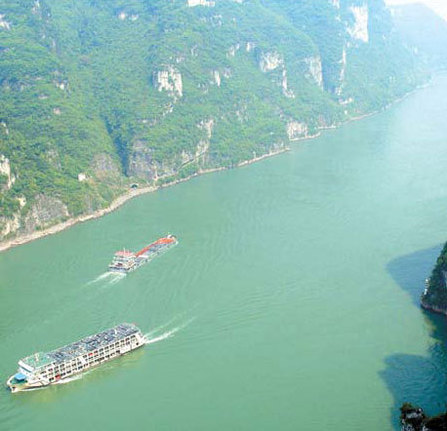The Yangtze River: China's southern belle

Both the Yellow and the Yangtze rivers are considered cradles of the Chinese civilization. Snaking 6,300 km between western China's Qinghai-Tibet Plateau and the East China Sea, the Yangtze River is often said to be the dividing line between North and South China. Geographers, however, technically regard Qinling Mountain and Huaihe River as the precise line of demarcation.
Because of the difficulty of crossing the river, the Yangtze historically served as the political boundary between forces in the north and south. Many significant battles took place on or near the river - the most famous being the Battle of Red Cliffs in AD 208, during the Three Kingdoms Period (AD 220-280).
As the world's third longest river and Asia's longest river, the Yangtze spans many diverse regions, and is known by several names.
In the Qinghai-Tibet Plateau, the river is known as Tongtian He, or Travelling-Through-the-Heavens River. Where it borders Sichuan and runs into Yunnan province, it is referred to as Jinsha Jiang, or River of Golden Sand. Only in its lower reaches is the great river referred to by the name most common to foreigners: the Yangtze.
For over two centuries, the Yangtze has served as a transportation highway and commercial thoroughfare. Ocean-going vessels can travel up the river by 1,000 km, and steamers can navigate up as far as Yichang, in the middle of China. Shanghai, China's largest metropolis, is known as the gateway to the Yangtze, as the city spans the Huangpu tributary just south of the river's mouth.
Numerous cities are located on the shore of the Yangtze. One is Nanjing, once known as the "South Capital" in China. Dating back at least two and a half millennia, Nanjing has been the capital of ten dynasties including the celebrated Ming (1368-1644).
But the city suffered calamity after the Japanese devastated it in 1937. Destruction, massacre, and torture desecrated this ancient city, ultimately claiming 300,000 civilian lives.
But it is the newly built Three Gorges Dam, the largest electricity-generating facility in the world, that now attracts international attention to the river.
The dam is the biggest infrastructure project undertaken in China since the Great Wall and the Grand Canal. The $24 billion dam spans nearly 2 miles across, and it generates 4 percent of China's total power output.
Traditionally the Yellow River civilization of the Han culture has received the most attention in the research of ancient Chinese history. However, recently the Ba and Chu cultures of the Yangtze River have caught the interest of archaeologists and historians. New archaeological work to better understand these cultures has begun in recent years.
|
Cruise liners sail through Three Gorges on the Yangtze River. Liu Junfeng |
(China Daily 07/14/2008 page10)















